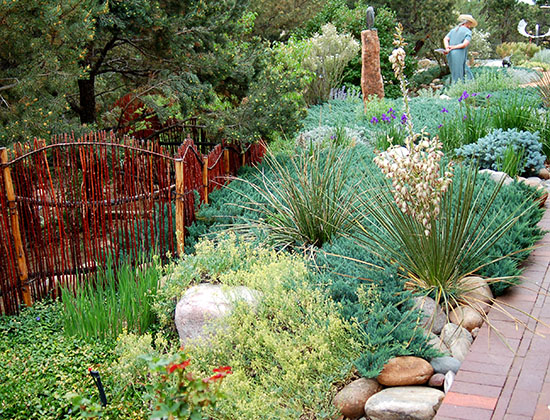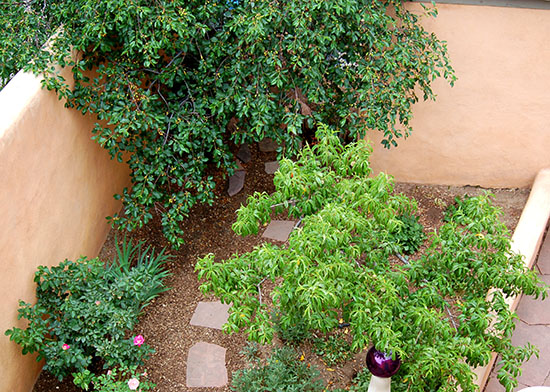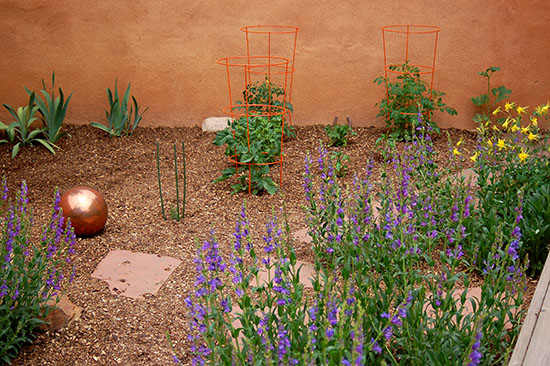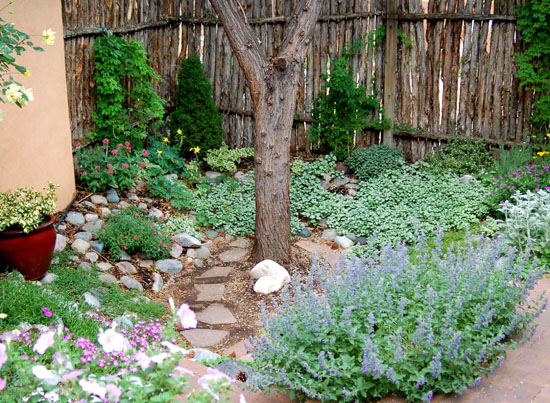On a tour of secret gardens in Santa Fe, New Mexico, Kathryn and I peek behind adobe walls for tantalizing glimpses of hidden treasures. Organized by the Santa Fe Botanical Gardens, the tour provides access to several small urban gardens not normally visible to passersby.
A beautifully sophisticated yet rustic fence made of reddish twigs defines the boundary between the garden and the natural environment beyond. This very low maintenance garden, features a beautiful mix of native and exotic plant materials all well adapted to local climate conditions and low rainfall. This is a xeriscape garden. Many people think that a xeriscape consists of a cactus and a couple of rocks surrounded by gravel. Obviously, a xeriscape can be much more than that.
In the beautifully designed private garden of the Richardson home an aesthetically appealing yet functional patio provides a transition between home and garden. This garden places all higher maintenance plantings needing supplemental water within the privacy of the backyard. Kathryn and I designed this garden several years ago.
A Montmorency pie cherry tree and a dwarf peach tree provide fresh fruit in season. The fruit trees are adjacent to the patio in the photo above.
The Richardson home also features a small section of the backyard garden devoted to vegetables such as tomatoes and chili peppers. Blue Penstemon strictus, and yellow Aquilegia chrysantha (yellow columbine) are native wildflowers mixed in with the vegetables.
In the front yard of the Richardson home we see a water conserving xeriscape of native wildflowers, shrubs, and succulents in dramatic contrast to the lush greenness of the private backyard. This portion of the garden faces south and is exposed to the intense heat of full desert sun. The function of the dry streambed is to direct and control excess rainwater from summer thunderstorms.
One aspect of gardening in the high desert of New Mexico is that most of the rainfall occurs during the “monsoon season” in the summertime. Snow in winter also provides some water, but most of the water arrives in torrential summer thunderstorms. All the precipitation (snow, hail, rain) that runs off the roof of the house is captured by downspouts and fed into cisterns which store the water in this garden. An extensive drip-trickle system distributes the water to organically grown vegetables.
Another water management technique is the sunken garden shown here. The rainwater and snowmelt which runs off of impervious surfaces such as the roof of the house is directed into these pit gardens which are sunken well below grade. A Russian olive tree rooted in the bottom of the pit shades the garden and provides a moist, shady microclimate for the plants surrounding it.
This adobe wall and dramatic blue gate provide access to a small urban garden featuring permeable paving using flagstones and creeping thyme. Permeable paving allows precipitation to percolate into groundwater without being shunted off into municipal stormwater drainage systems.









Leave a Reply